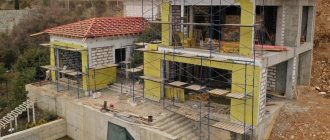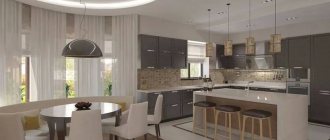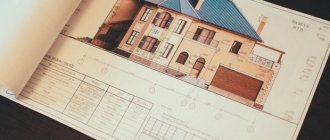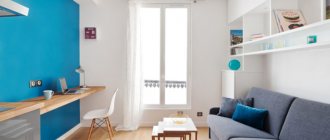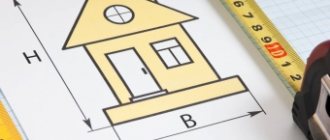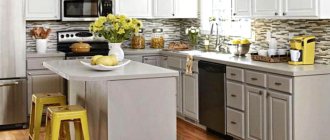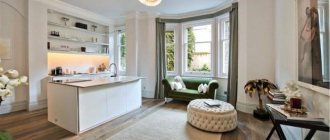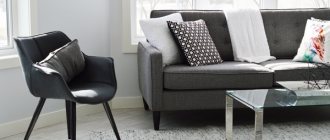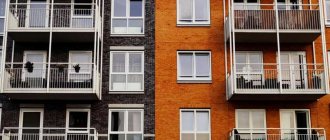Real estate
00:00, 11/23/2020 8 Plot: House in focus
What is included in the area of an individual house, how is the tax calculated and how to save on it
Photo: architekrym.ru
What is the difference between an attic and an attic, is the open terrace included in the total area of the house, why the number of storeys and the number of floors are different things, what replaced the technical data sheet and how to cheat when designing the location of the bathhouse - in the new article of the “House in Focus” project. Cadastral engineer Liliya Aleksandrovna Kupchikhina helps us figure out which elements are included in the total area of the house and which are not. Armed with this information, you can plan in advance where you will place a bathhouse or garage on the site, how you will distribute the residential floors, and whether you decide to build a separate gazebo instead of a terrace with a tea table.
Room area
All measurements are taken on the internal walls.
The difficulty in calculating the square footage of a room is that the room most often has an irregular shape. There may be large recesses reserved for the sleeping area, or sloping walls. The footage of individual rooms is determined in order to calculate the amount of finishing materials. By adding up their areas, the footage of the building as a whole is obtained. It should match or not differ much from the numbers from the construction project. In this case, we must not forget about cold storage rooms and other rooms. To find the area of a room, measure the length and width of the room and then multiply them. If the room has niches and ledges, then it is better to divide it into regular shapes (square, rectangle), find their footage, and then fold them. In a two-story house, the staircase and the balcony on the second floor are taken into account.
When the recesses and protrusions are small, you can take the entire room as a regular figure (a rectangle, for example) and calculate its area. And then add the footage of the niche or subtract the footage of the ledge.
Room area
Calculating the footage of a round room is a little more difficult. To do this, you need to measure its diameter and divide by 2.
The resulting value will be the radius. Multiplying pi by the squared radius gives the area of the circle. If the room, or part of it, is semicircular in shape, then the result must be divided in half.
If the room is triangular, then you need to subtract each side from the semi-perimeter and multiply the resulting values, and then find the root. Where P is the semi-perimeter of the triangle.
General
If it is necessary to independently calculate the total area of the house, the owner of the building is faced with confusion in regulatory documents. In the set of construction rules (formerly SNiP), it is recommended to calculate the total footage as in apartment buildings. This means that street extensions (verandas and terraces) and balconies and loggias are taken into account. This approach is convenient for developers offering DDU to clients. The cost of housing will increase due to the total area. That is, if the contract specifies a footage of 53 sq.m., then it includes a balcony or loggia. As a result, the buyer's expectations may not be met. Therefore, the developer must inform the DDU participant about the method for calculating footage.
However, in residential buildings, the total footage does not include balconies, loggias, terraces and verandas, which is regulated by the Housing Code. But if the overall indicator is significantly higher than the residential one, then the rooms will be tiny, and the utility rooms (kitchen, toilet, etc.) included in the total area will be spacious.
When calculating, you should take into account a number of nuances and exclude areas:
- niches less than 2 meters high;
- floor above the stairs, if the distance from the floor to the bottom of the steps is less than 1.6 m;
- occupied by a stove or protruding structures;
- rooms in the attic, if the floor is less than 1.5 meters (slope 30 degrees);
- rooms in the attic, if the floor is less than 1.1 meters (slope 45 degrees);
- rooms in the attic, if the floor is less than 0.5 meters (slope 60 degrees).
Residential
Before building or buying a house, you need to decide how much space future residents will need for comfort. It’s good if the owners plan the location and purpose of the rooms, right down to the furniture. It is possible to create comfortable housing if you know the square footage of living spaces. To do this, let’s figure out how to calculate living space and what it is.
The living area of the house is determined by adding up the footage of all premises intended for living. These do not include pantries and built-in wardrobes. The living area differs from the total area in the absence of utility rooms when calculated.
The living area of a private house includes:
- bedrooms;
- living rooms;
- offices;
- children's rooms;
- game rooms;
- rest rooms.
In order to increase the space, the owners equip a room for permanent use for ventilation, a boiler, and electrical panels, if any. The technical floor can be located in the basement or attic. If space allows, then a billiard room, an office or even a bedroom will be equipped there. In this case, the technical, attic and basement floors are also taken into account in conjunction with other living rooms.
Useful
Usable area is the space that is used by residents for living and storing property. It does not include stairs and the area underneath them, external balconies, technical rooms (attic or basement), porch, underground for foundation ventilation. To calculate the usable area, you need to add up the areas of all living and utility rooms, balconies and mezzanines located inside the building.
The choice of wall material also influences the space. Thick walls will reduce the usable area, and thin walls - vice versa.
Building a house takes time and requires a significant investment of effort. Calculating footage is an important part of preparation for construction. Its quality allows you to choose the right materials and not overpay for excess.
>What is living space in a private house
How is it determined for a new building?
When the future owner buys housing in a house under construction, a share participation agreement is concluded - a document that states the terms of cooperation, indicates design solutions, and the layout of all premises. When the living area of a new building is calculated, measurements and calculations are made taking into account reducing factors. The agreement clearly regulates all indicators.
The development company indicates which footage is taken as a basis - general, or based on space suitable for living. When the latter is the main value, the cost of 1 m2 of housing increases, and vice versa, it decreases if the first is considered the main one.
When carrying out a comprehensive renovation, the location and total amount of living space is always taken into account. This number is important for determining the required number of pipes, communications, and space for installing the air conditioner. Experienced specialists will help you calculate everything correctly.
Expert opinion
Ovadyuk Georgy
If you do such a complex task yourself, the results may not be ideal - for example, the ventilation will not be of sufficient quality.
Sometimes, during redevelopment, the living space indicator changes. This can happen after the living room merges with part of the corridor (this is often done to expand the first). A balcony or loggia can become suitable for living if the wall between it and the room is demolished, heating and glazing are installed.
Any changes of this type must be registered and included in the registration certificate.
See also: Mortgage for a garage and parking space in Sberbank in 2021
Residential and non-residential premises: what are they and for what purposes are they suitable? Let's deal with it wisely
- The square footage of the apartment includes the area of all residential and utility rooms included in it, together with balconies, unheated storage rooms, loggias, verandas, and vestibules. Utility rooms are combined or separate bathrooms, bathrooms, kitchen spaces, corridors, built-in wardrobes.
- For a residential building, this indicator is the sum of the areas of individual apartments.
- The total area of the dwelling is equal to the sum of all its areas (residential and auxiliary use) with the exception of the space on the balcony, terrace, veranda or loggia according to the Housing Code of Russia - Article 15, paragraph 5). The cadastral passport indicates this type of property characteristics. It is also a characteristic of the object entered into the register of rights.
- The total area indicator for a building is calculated by summing similar values for all apartments.
- The area of living rooms in an apartment constitutes its living area, and the apartment-by-apartment values of this value for the entire house constitute its living area.
How to measure
Information for all rooms is indicated in the technical passport for the apartment. Sometimes it happens that there are discrepancies in the actual measurements. For measurements, in addition to the technical passport, you will need a tape measure, paper, calculator and pencil. The actions are:
The apartment diagram is drawn on a sheet of paper. You also need to draw utility rooms - storage rooms, built-in wardrobes.
Using a tape measure, measure the length of the walls according to the level of the baseboard. The amounts are converted into meters and recorded on the diagram.
If there are curves or recesses in the configuration of the room, it is divided into separate figures, each with its own value indicated.
Width and length are multiplied.
How to find out what is included in the living space of a private house, and how it can be calculated
- Area of premises. This is a calculation of the size of the room, determined by the distance between the walls without taking into account the baseboards. If a stove or fireplace is installed in a private house, its dimensions are excluded from the area of the premises during calculations.
- The total area of the building is the total area of all residential and non-residential premises, which includes rooms, kitchen, vestibule, corridors, hallway and built-in closets. Previously, when calculating the total area, verandas, terraces and outdoor areas, balconies and loggias were taken into account, but now this rule has ceased to apply.
- Living area is the total size of living rooms; in documents they are taken into account as rooms intended for permanent residence of people. These are the kitchen, living room, bedroom, children's room, study, and this concept also includes dressing rooms.
- Usable area (in foreign standards it is designated as “used”). This is the total area of all premises; the area of stairs and staircases, as well as elevator shafts and ramps is excluded from this value.
Calculation coefficients
It is easy to determine the living area - just take the total value of square meters in all rooms that fit this definition. Additionally, certain coefficients specified in SNiPs are taken into account. Each room has its own.
If for some reason the dimensions of the loggia are calculated, a coefficient of 0.5 is applied. For balconies and terraces – 0.3. For buildings that have verandas, a coefficient of 1 is provided. The same figure is used when cold (unheated) storerooms are taken into account.
The calculations are easy, just add the meters of each room. True, this rule only applies if the shape of the room is correct (geometrically proportional square, rectangle). If not, you need to measure along the walls with a tape measure.
Interesting fact!
You need to measure the area of the walls using the inside of the baseboard. If you don’t want to do this, you can ask for an extract from the BTI. The exact values for all rooms are indicated there.
It is noteworthy that the coefficients for loggias and balconies are different, because they are different. The first has a ceiling with walls on the sides, and is located, as it were, inside the building. The balcony, on the contrary, extends beyond the boundaries of the house.
Do you need repairs?
We have already renovated more than 500 apartments, we will be happy to help you too
Which rooms are considered residential and non-residential premises in a private house
2. Residential premises are recognized as isolated premises, which are real estate and are suitable for permanent residence of citizens (meets established sanitary and technical rules and regulations, other legal requirements (hereinafter referred to as requirements)).
An apartment is recognized as a structurally separate room in an apartment building, providing direct access to the common areas in such a house and consisting of one or more rooms, as well as auxiliary premises intended to satisfy citizens' household and other needs related to their residence in such a separate apartment. indoors. In practice, an apartment is considered a separate living space intended and used for living, which has a separate exit to the street (to the courtyard, staircase or common corridor) and a separate kitchen * (57). The absence of functional parts (areas, volumes) of other apartments (common areas) within its boundaries is also referred to as characteristics of an apartment * (58).
Norms and procedures for individual housing construction, rules for individual housing construction – Sale of land plots without a contract
- Load-bearing and enclosing structures of residential premises must be in working condition and ensure the safe stay of citizens and the safety of engineering equipment
- Residential premises must be arranged and equipped in such a way as to prevent the risk of injury to residents when moving in and around the residential premises.
- Residential premises must be provided with engineering systems (electric lighting, drinking and hot water supply, drainage, heating and ventilation, and in gasified areas also gas supply). In settlements without centralized utility networks, one- and two-story buildings may not have running water or sewerage latrines.
- Engineering systems, equipment and mechanisms located in residential premises must comply with sanitary and epidemiological safety requirements. It is not allowed to combine ventilation ducts of kitchens and sanitary facilities (auxiliary premises) with living rooms.
- Engineering systems must be placed and installed in accordance with the safety requirements established in current regulations and the instructions of equipment manufacturers.
- External enclosing structures of residential premises must have thermal insulation that ensures in the cold season a relative humidity of no more than 60 percent, a temperature of heated premises of at least +18 degrees Celsius, as well as insulation from the penetration of cold air, vapor barrier, absence of moisture condensation on internal surfaces and preventing accumulation of excess moisture in residential building structures.
- Residential premises must be protected from the penetration of rain, melt and ground water and possible domestic water leaks from engineering systems using structural means and technical devices.
- The permissible height of a residential building in use must correspond to the class of the building's structural fire hazard and the degree of its fire resistance established in the current regulations.
- The space-planning solution for residential premises, the minimum area of rooms and premises for auxiliary use intended to satisfy citizens' household and other needs related to their residence in residential premises (except for the hallway and corridor), must ensure the possibility of placing the necessary set of furniture and functional equipment, taking into account ergonomic requirements.
- The height (from floor to ceiling) of the rooms and kitchen (kitchen-dining room) in climatic regions IA, IB, IG, ID and IVa must be at least 2.7 m, and in other climatic regions - at least 2.5 m. Height corridors, halls, hallways, mezzanines should be at least 2.1 m.
- The floor level of the living space located on the ground floor must be higher than the planning level of the ground.
- Placing a restroom, bathroom (shower) and kitchen above the rooms is not allowed.
- Rooms and kitchens in living areas should have direct natural light.
- Other auxiliary premises intended to satisfy citizens’ household and other needs may not have natural lighting.
- In residential premises, permissible levels of vibration from internal and external sources during the day and at night must correspond to the values established in current regulatory legal acts. (Resolution of the Government of the Russian Federation dated January 28, 2006 No. 47 “On approval of the Regulations on recognizing premises as residential premises, residential premises unsuitable for habitation and an apartment building as unsafe and subject to demolition or reconstruction”).
Information support center
According to Part 1 of Article 174 of the Housing Code of the Russian Federation, at the expense of the capital repair fund, within the amount formed on the basis of the minimum amount of contribution for capital repairs, only the work provided for in Part 1 of Article 166 of the Housing Code of the Russian Federation, and work provided for by the law of the constituent entity of the Russian Federation, can be financed. repayment of loans received and used to pay for these works, and payment of interest for the use of these loans.
It should be noted that in accordance with Part 7 of Article 189 of the Housing Code, if major repairs in a house in which the owners of the premises are forming a capital repair fund in a special account are not carried out within the time period stipulated by the regional program, and in accordance with the procedure When establishing the need for major repairs in a house, it is necessary to perform any type of work provided for for this house by the regional program, the local government body makes a decision on the formation of a capital repair fund on the account of the regional operator and sends such a decision to the owner of a special account.
House area: total, built-up area and others
- The area of niches with a height of 2 meters or more should be included in the total area of the premises in which they are located. The area of arched openings should be included in the total area of the room, starting from a width of 2 meters;
- the floor area under the flight of internal stairs, with a height from the floor to the bottom of the protruding structures of the flight of 1.6 meters or more, should be included in the total area of the room in which the stairs are located;
- the area occupied by protruding structural elements and heating stoves, as well as located within the doorway, should not be included in the total area of the premises.
6. The total area of a residential premises, a residential building consists of the sum of the area of all parts of such a premises, a residential building, including the area of auxiliary premises intended to satisfy citizens’ household and other needs related to their residence in the residential premises, with the exception of balconies, loggias, verandas and terraces. The area of auxiliary premises includes the area of kitchens, corridors, baths, toilets, built-in closets, storage rooms, as well as the area occupied by the internal staircase. The measurement of distances used to determine the total area of a residential premises, a residential building, is carried out along the entire perimeter of the walls at a height of 1.1 - 1.3 meters from the floor. When determining the total area of a residential premises or residential building, you must:
Auxiliary area
Many citizens living in their own apartments or in social rented premises often cannot determine the type of space they occupy.
As soon as the need arises to carry out legal actions with an apartment or house, the need to clarify what is considered living space increases? For example, when selling an apartment or house, the buyer will definitely inquire about the size of the living space.
What is the living area of an apartment?
According to the rules, the area of the apartment of the same name includes the sum of the areas of the living rooms. What is a living room? Unlike such a concept as the living space of an apartment, a living room is the narrowest term.
It includes a structurally separate indivisible part of the apartment, the dimensions of which are taken into account as part of the living area of the entire apartment or house. This occurs in full compliance with legal norms, in particular, with accounting rules at the state level.
Note that the area of a residential room or rooms in the apartment or house itself is the main one. The term of the same name discussed in this article includes:
- Bedroom;
- living room;
- cabinet;
- rest room;
- dining rooms
The term living space of a house (apartment) does not include:
- closets;
- stairs;
- premises for household needs;
- bathrooms.
Living area of the apartment
Since the living area of a residential premises consists of rooms, it is quite obvious that such premises should be classified as residential according to a certain document. Thus, even at the design stage of a building or structure, such premises are defined as residential. It is believed that the height cannot be less than 2.2 meters.
If we speak in dry formal language, then in many documents based on the housing legislation of the Russian Federation, you can see that living rooms are intended for citizens to live in them on a permanent basis. By the way, to add to the above: the living area includes such areas as an alcove and a dressing room.
In principle, the same applies to such a thing as the living space of a house. When contacting specialists, for example, when selling a house, they will be happy to explain all the nuances associated with determining the size of the room. In answer to the question of what the living area of an apartment is, many citizens confuse this term with the general dimensions of the living space.
The general area is determined by the sum of the areas of the premises, which include:
- built-in cabinets;
- loggias;
- verandas;
- storage rooms.
When answering the question of what is the living space of an apartment, you should understand that this concept does not include loggias and balconies, verandas and terraces, storage rooms and built-in wardrobes.
//www.youtube.com/watch?v=xO498Xk17Ew
The area of residential premises is determined by their dimensions, which are measured between the finished wall surfaces and partitions at the level of the flooring.
What is living space in a private house
Skirting boards are not subject to credit. The area in the house that is given over to the stove, including the fireplace that is part of the heating system throughout the entire building, is decorative. Therefore, it is not included in the area of buildings and structures.
As for the area of open premises, for example, balconies and loggias, they should be determined by their dimensions, which are measured along the contour of the internal purpose. It is located between the wall of the building and the fence, an open space without taking into account the area occupied by the fence.
In any case, the specialist will more specifically indicate all the rules for measuring the room.
Existing requirements
The general requirements for determining the area of a room can be considered the following: the area of the room (as, in fact, the total area) is determined as the space of the simplest geometric figure (rectangle or trapezoid) or by dividing such an object into geometric figures, as well as the amount of payments for such figures.
Living space - living room - living area
Residential premises are isolated premises intended for permanent residence of citizens. Zh.p. refers to real estate.
Types of residential premises (Article 16 of the Housing Code of the Russian Federation, Article 673 of the Civil Code of the Russian Federation)
- Residential building or part of a residential building*.
- Apartment or part of an apartment.
- Living room**.
* This refers to a single-apartment residential building (see paragraph 2 of Article 673 of the Civil Code of the Russian Federation, as well as Chapter 6 of the Housing Code of the Russian Federation).
** Part of the room cannot be considered as an independent object of housing relations.
In accordance with Article 15 of the RF Housing Code, the total area of residential premises includes “the area of auxiliary premises intended to satisfy citizens’ household and other needs related to their residence in residential premises,” but does not include “balconies, loggias, verandas and terraces.”
Living room is a part of a residential building or apartment intended for use as a place of direct residence of citizens in a residential building or apartment (Article 15, paragraph 4 of the Housing Code of the Russian Federation).
Living area is the sum of the areas of all living rooms.
It is necessary to distinguish between a living room as a separate type of living space (i.e., can a citizen be registered there) and a living room as part of the living area of an apartment or house (which is taken into account when determining the living area).
Which rooms are considered residential?
From the previous definitions it is clear that a living room is one that is intended for direct living.
How to calculate the living area of a house
That is, the BTI employee taking measurements of the house will determine the living area in accordance with the names of the rooms that are indicated in the project or floor plan. Apparently the technique is as follows:
- All areas are measured.
- Areas that are not included in the total area (The area of an apartment in a residential building is defined as the sum of the areas of living rooms and utility rooms, excluding loggias, balconies, verandas, terraces and cold storage rooms, vestibules . - BTI Instruction, clause 3.36).
- The area of utility rooms is determined (Utility rooms include the area of kitchens, corridors, baths, toilets, built-in closets, storage rooms, as well as the area occupied by the apartment staircase - BTI Instruction, clause 3.36).
What premises do we still have:
- bedroom
- cabinet,
- restroom,
- dining room*
- living room.
* Please note that the “kitchen-dining room” will most likely be classified as a utility room (after all, it is a kitchen).
If you really want to increase the share of living space, you can call it a dining room in the project, or even better, a living room, and to a fair question from a BTI engineer: “Where is your kitchen?” - say that you are going to make a summer kitchen outside.
If I were a BTI employee, I wouldn’t believe it :).
The vestibule is clearly classified as premises that do not belong to the general area. The hallway is not on this list, but it is definitely taken into account in the total area when measuring the apartment.
Source: //akrchel.ru/vspomogatelnaja-ploshhad/
Letter from the Ministry of Regional Development of the Russian Federation dated November 22, 2012
The values of the total area of a residential premises (apartment), non-residential premises in an apartment building used when calculating the amount of payment for utility services in accordance with the Rules for the provision of utility services should be determined on the basis of the data contained in the document confirming the right of ownership (use) of the premises in an apartment building , a transfer deed or another document on the transfer by the developer of premises in an apartment building, a technical passport of a residential premises (apartment) or a technical passport of an apartment building, and the value of the total area of all premises in an apartment building, the total area of premises included in the common property in an apartment building, the total area of all residential premises (apartments) and non-residential premises in an apartment building should be determined on the basis of the data contained in the technical passport of the apartment building.
In accordance with paragraph 40 of the Rules for the provision of utility services to owners and users of premises in apartment buildings and residential buildings, approved by Decree of the Government of the Russian Federation of May 6, 2011 No. 354 (hereinafter referred to as the Rules for the provision of utility services), the consumer of utilities in an apartment building, regardless of depending on the chosen method of managing an apartment building, as part of the payment for utility services, it separately pays for utilities provided to the consumer in residential or non-residential premises, and payment for utilities consumed during the use of common property in the apartment building.
- An essential condition of the contract for the sale of a residential building, apartment, part of a residential building or apartment in which persons live who, in accordance with the law, retain the right to use this residential premises after its acquisition by the buyer, is a list of these persons indicating their rights to use the residential premises being sold.
- A contract for the sale of a residential building, apartment, part of a residential building or apartment is subject to state registration and is considered concluded from the moment of such registration.
- The specifics of the purchase and sale of residential premises that meet the conditions for classification as economy class housing established by the authorized federal executive body are determined by law.
Area is the main parameter for carrying out technical inventory and statistical accounting of both types of real estate in the Russian Federation. Calculations for the consumption of utilities, rental housing, and repair work are also carried out based on the value of this indicator.
Basic terms in construction
Many people have completely different concepts about the area of a private house
When designing a building, the designer and developer use 4 basic concepts to calculate:
- Area of premises. This is a calculation of the size of the room, determined by the distance between the walls without taking into account the baseboards. If a stove or fireplace is installed in a private house, its dimensions are excluded from the area of the premises during calculations.
- The total area of the building is the total area of all residential and non-residential premises, which includes rooms, kitchen, vestibule, corridors, hallway and built-in closets. Previously, when calculating the total area, verandas, terraces and outdoor areas, balconies and loggias were taken into account, but now this rule has ceased to apply.
- Living area is the total size of living rooms; in documents they are taken into account as rooms intended for permanent residence of people. These are the kitchen, living room, bedroom, children's room, study, and this concept also includes dressing rooms.
- Usable area (in foreign standards it is designated as “used”). This is the total area of all premises; the area of stairs and staircases, as well as elevator shafts and ramps is excluded from this value.
Also during construction, the concept of “building area” is very important: according to the law, it should not exceed 30% of the total area of the site. This value includes the total area of the horizontal section of the building drawn at the level of the basement.
In this case, this value includes the area of the porch, terrace or veranda, but does not include the size of the balcony on the second floor if it does not have additional load-bearing pillars.
Knowledge of all these concepts allows you to understand what size a house should be and determine the requirements for the developer and designer. In addition, the total and living area are indicated in advertisements when searching for a buyer for a house.
Data on the size of the total and living area of the building are entered into the technical passport of the residential property and the certificate of registration of the property.
What is the difference between common and living space?
The living area of a private house includes the area of living rooms
The concept of the total area of the house is taken into account when calculating the norm that should fall on each person living in a given room. If it does not meet the standard, then the person has the right to get on the waiting list to improve their living conditions.
In addition, this parameter is taken into account when calculating the cost of heating if a heat meter is not installed in the apartment or house. In this case, you have to pay for all heated rooms in the building.
The living area must be indicated in advertisements when selling, since this parameter allows you to estimate the actual size of the living space. So in a large house a spacious hallway or vestibule can be equipped, but the rooms themselves will be small and cramped. The decision must be made not only after evaluating the documents, but also after a visual inspection of the house.
If the management company incorrectly calculates the cost of heating due to the total area incorrectly indicated in the documents, it is necessary to reissue the technical passport, after which the corresponding changes are made to the cadastral passport and certificate of ownership. After this, the management company will have to recalculate.
Nuances of assessing the total and living space
Attic area is a controversial issue when assessing housing
When calculating the total and living space, the buyer and seller or the customer and the developer often have disagreements, since several important nuances are not taken into account:
- If the building has niches whose height is less than 2 m, they cannot be taken into account as part of the living area of the room.
- If the area of the space under the flight of stairs is no more than one and a half meters, it will also not be taken into account when assessing the size of the house.
It is especially difficult to calculate the dimensions of the living space of the attic floor or the attic used. In this case, the main parameter for calculation becomes the roof slope. If the roof slope is 27 degrees, the total living area includes only a part of the room with a height of 1.5 meters to the roof.
Each future homeowner needs to learn how to independently measure the total and living area in order to check the compliance of the finished building with the data stated in the project. To do this, the room must be cleared of furniture, and then measure the length and width of the room. The resulting dimensions are multiplied, thus measuring the size of each room in the house.
An accurate calculation of the total and living area is necessary when designing a future home and during subsequent acceptance of the building after completion of construction. When selling, this is one of the key parameters that directly affects the assessment of the final cost of the building.
This video will tell you how to correctly calculate the area of a room:
>How to calculate the living area of a house
Calculation of room area
- First you need to measure one side of the room. Using a tape measure, for accuracy it is better to take a construction tape (it has sufficient length and it keeps an even line well), calculate the room by length and width. Take measurements along the walls. For ease and simplicity of calculation, you need to free up all the space near the wall and place the tape measure along the floor plinth. It should lie flat, but at the same time freely, without tension. Record the measurement results in a notebook. Similarly, take measurements in turn in all other rooms of the house or apartment.
- The area of the rooms must be calculated using this formula: L (length) x W (width) = P (area). Write down and save each value obtained, making notes about the correspondence of each area to a specific room. With this approach to work, you will not need repeated measurements.
How is the area of a house calculated?
In accordance with the Housing Code of the Russian Federation, the concept of total area includes the sum of the areas of all rooms and parts of a given premises, including the areas of rooms (premises) for additional or auxiliary purposes (use), which are intended for household and other needs of citizens. Such premises are considered to be: kitchens, corridors, bathrooms, etc.
- find out the total area of the room;
- determine the living area;
- determine standards for providing residential space to categories of citizens who need housing;
- determine the accounting standard for living space;
- calculate utility bills and payment subsidies;
- determine the inventory value of housing, etc.
The living area must be indicated in advertisements when selling, since this parameter allows you to estimate the actual size of the living space. So in a large house a spacious hallway or vestibule can be equipped, but the rooms themselves will be small and cramped. The decision must be made not only after evaluating the documents, but also after a visual inspection of the house.
If the management company incorrectly calculates the cost of heating due to the total area incorrectly indicated in the documents, it is necessary to reissue the technical passport, after which the corresponding changes are made to the cadastral passport and certificate of ownership. After this, the management company will have to recalculate.
What does the area of the apartment affect?
The legislator distinguishes three types of residential premises:
- general;
- residential;
- housing area.
The total area of the residential premises is used for the following purposes:
- heating fee ;
- calculating the homeowner’s share in the common property of an apartment building (the share is proportional to the size of the total area);
- calculation of the tax base when paying tax on land located in common shared ownership (proportional to the size of the total area);
- calculating the tax base when paying tax on residential premises and tax deduction for property tax for individuals;
- determining the cost of 1 m2 of total area when transferring residential premises to citizens if their previous home is recognized as unsafe and included in the regional program for relocating citizens from unsafe housing stock;
- determining the standard for providing housing;
- determining the accounting standard for residential premises based on the size of which, the level of housing provision for citizens is determined;
- determining the size of housing space allocated under a social rental agreement or for ownership of various categories of persons (military personnel, disabled people, orphans, etc.);
- calculating the amount of social payments to participants in the subprogram “Providing housing for young families” of the Federal Target Program “Housing” for 2015-2020;
- calculating the amount of gratuitous social payments for housing using federal budget funds.
Until January 1, 2021, all subjects of the Russian Federation must switch to the procedure for calculating property taxes based on the cadastral value of the apartment.
At the moment, 28 constituent entities of the Russian Federation have switched to this order, including Moscow, Buryatia, Bashkortostan, Vladimir, Ivanovo regions, etc. In connection with this change in the procedure for calculating tax, the tax burden on citizens increases, so the legislator established deductions (tax-free areas) for residential properties in the amount of 20 m2 of total area for an apartment, 10 m2 for a room, 50 m2 for Houses.
Determining the size of living space is advisable for:
- determining the size of the sanitary standard for housing;
- provision of housing in a hostel (at least 6 m2 per person) (Article 105 of the Housing Code of the Russian Federation);
- housing assessments for concluding a real estate purchase and sale agreement;
- drawing up an act of inspection of the living conditions of a minor by the guardianship and trusteeship authorities;
- concluding a mortgage ;
- drawing up a transfer and acceptance certificate under contracts of sale, exchange, rent, social tenancy.
Determining the area of the premises is carried out for the purposes of:
- determining the size of housing owned by a citizen when providing him with an apartment under a social tenancy agreement;
- statistical accounting of the housing stock in the Russian Federation, calculating the amount of payment for housing and utilities, determining the social standard of housing and other purposes;
- calculating the cost of payment for general house needs;
- calculating the amount of subsidies for housing and utilities.
Thus, the three categories of residential premises are used for different purposes and it is important to determine when and which category is used in accordance with the legislation of the Russian Federation.
How to calculate the area of a house - calculation formula
The common area of any household is represented by the total area of all existing parts of the home, including the results of measurements of the sizes of secondary (utility) premises necessary to solve everyday problems. Secondary (auxiliary) areas include the space occupied by the kitchen, corridor, bathroom, toilet, storage room, areas of shelves built inside the walls, as well as the area where the internal staircase is located.
Using the already known formula, we will obtain an indicator of the area of one of the walls. In the same way, we will calculate the area of all external walls of a residential building. After this, you need to add up all the obtained values and the result will be the area of the external walls of your house.
The requirement of the developer of an apartment building to a participant in shared construction to pay the cost of additional areas of the loggia and balcony included in the apartment in addition to the total area of the apartment is unreasonable, if payment for such areas was not separately agreed upon in the agreement for participation in shared construction.
11. The distances used to determine the area of the non-residential premises of the attic floor are measured at the height of the sloping ceiling (wall): 1.5 meters - at a slope of 30 degrees to the horizon; 1.1 meters - at 45 degrees; 0.5 meters - at 60 degrees or more. For intermediate values, the height is determined by interpolation. 12. The area of a residential premises (apartment, room) consists of the sum of the areas of all parts of such premises, including the area of auxiliary premises intended to satisfy citizens’ household and other needs related to their residence in residential premises, with the exception of balconies, loggias, verandas and terraces, exploitable roof. The area of auxiliary premises includes the area of kitchens, corridors, baths, toilets, built-in closets, storage rooms, as well as the area occupied by the apartment staircase, and others. The area of a residential premises includes the area of niches with a height of 2 meters or more, arched openings with a width of 2 meters or more, the floor under the flight of internal stairs with a height from the floor to the bottom of the protruding structures of the flight of 1.6 meters or more. The area of a residential premises does not include the area occupied by protruding structural elements and heating stoves, as well as the area within the doorway. 13. The distances used to determine the area of living space are measured along the entire perimeter of the walls at a height of 1.1 - 1.3 meters from the floor. The distances used to determine the area of the living space of the attic floor are measured at the height of the sloping ceiling (wall): 1.5 meters - at an inclination of 30 degrees to the horizon; 1.1 meters - at 45 degrees; 0.5 meters - at 60 degrees or more. For intermediate values, the height is determined by interpolation.
Determining the area of an apartment purchased under an equity participation agreement
At the moment, there is no method for determining the cost of apartments under an equity participation agreement. Typically, builders determine the cost based on the share of the living area in the total area of all apartments in the building under construction.
The share participation agreements indicate the projected area of housing, including:
- living space;
- area of auxiliary premises;
- balconies and loggias.
In this regard, there may be cases when the actual area of the transferred residential premises differs from the design area specified in the contract.
If in the contract the parties provided for the possibility of increasing the area and the procedure for making an additional payment in connection with this, then such a deviation is not considered a violation of the rights of the participant in shared construction, since the magnitude of the deviation does not indicate a deviation by the developer from the terms of the contract and the unsuitability of the residential premises for habitation.
If the share participation agreement does not contain a clause on a possible increase/decrease in the actual area, then the participant has the right to go to court with claims against the developer for the return of the overpaid amount. The court will calculate the amount of money taking into account the size of the total area of the apartment, calculated according to the rules of Art. 15 Housing Code of the Russian Federation.
Example
N. filed a claim for recovery from the developer of overpaid funds under the agreement for participation in shared construction. N. entered into a share participation agreement with the developer; upon completion of construction, the developer was to transfer to N. a one-room apartment, the size of which was 50 m2, the living area was 38 m2, and the balcony was 5 m2.
The cost of the apartment was calculated based on the entire area of the apartment, without using coefficients. N. signed the apartment acceptance certificate without any comments and did not express any complaints regarding the execution of the contract. The parties did not indicate in the agreement that they would apply a reduction factor to the calculation of the balcony area.
In accordance with the “Instructions on accounting of housing stock in the Russian Federation” dated 08/04/1998, a coefficient of 0.3% is applied for balconies and terraces. Accordingly, the price of the apartment had to be calculated taking into account the specified coefficient. In this regard, the court recognized I.’s claims as legitimate and satisfied the claim.
What is the total area of an apartment building
Underground areas for ventilation of the building, unused attic, technical underground, technical attic, in non-residential engineering communications with vertical (in channels, shafts) and horizontal (in interfloor space) wiring, as well as vestibules, porticoes, porches, external open stairs and ramps are not included in the building area.
Also, according to clause 17 of Appendix 2 of the Rules for the provision of utility services to owners (Resolution of the Government of the Russian Federation dated 05/06/2011 N 354), the total area of premises included in the common property in an apartment building is defined as the total area of the following premises that are not parts of the apartments of the apartment building and intended to serve more than one room in an apartment building (according to the information specified in the passport of the apartment building): the area of inter-apartment landings, stairs, corridors, vestibules, halls, vestibules, wheelchairs, security (concierge) premises in this apartment building that do not belong to individual owners.
If you intend to buy your own house or any other housing, the primary and most important questions arise: the size of the house or its area and cost. The price depends on the area of the home. In order for the purchase and sale transaction to go through cleanly, without deception, you need to independently verify the authenticity of the specified area of the home, which is stated in the contract. In this case, you definitely need to know exactly how the area of the house is calculated.
It is necessary to count square meters in those moments when you should:
- find out the total area of the room;
- determine the living area;
- determine standards for providing residential space to categories of citizens who need housing;
- determine the accounting standard for living space;
- calculate utility bills and payment subsidies;
- determine the inventory value of housing, etc.
How will the house tax be calculated depending on the area?
By the way, about taxes. In accordance with Art. 403 of the Tax Code of the Russian Federation, “the tax base for a residential building is determined as its cadastral value, reduced by the cadastral value of 50 square meters of the total area of this residential building.”
And if the owners of the house (that is, you) have three or more minor children, then another 7 square meters for each child will be “removed” from the tax base. Important: as soon as your heir turns 18, this relaxation ceases to apply to him. And if after celebrating his birthday there are only two minors left, the benefit for them is canceled too.
The tax on an already built house, registered with the cadastral register, can later be calculated using the tax calculator of the Federal Tax Service of Russia (however, you will need to prepare the cadastral number of the property in advance - it is unlikely that you will remember it by heart).
And if the owners of the house (that is, you) have three or more minor children, then another 7 square meters for each child will be “removed” from the tax base. Photo mosreg.ru
What does living space include?
To learn how to make correct calculations of square meters, you will have to familiarize yourself with the current regulations and legislative acts.
In accordance with the Housing Code of the Russian Federation, the concept of total area includes the sum of the areas of all rooms and parts of a given premises, including the areas of rooms (premises) for additional or auxiliary purposes (use), which are intended for household and other needs of citizens. Such premises are considered to be: kitchens, corridors, bathrooms, etc.
Living area of the apartment
Balconies, loggias, verandas, terraces do not apply to them.
But the technical inventory authorities use the Instructions on the accounting of the housing stock of the Russian Federation to determine the area of premises. And therefore, the BTI documents for determining the area of an apartment or individual residential building contain general information, where the accounting includes a balcony, loggia, terrace, etc. Such premises are included in the total area, but with a reduction factor: 0.5 – loggias; 0.3 – terraces and balconies; 1.0 – also terraces and cold storage rooms.
How to determine
To find out what the living area is, you need to calculate the number of square meters of the entire space intended for living. This:
hall (guest room);
To obtain the quantity, each space is calculated separately. For example, in a one-room apartment this area is proportional to the parameters of the only room - the bedroom-living room, in a two-room apartment - the bedroom and living room.
See also: How to get a subsidy for the purchase of housing in 2021
Important!
Some people mistakenly attribute the kitchen or loggia to this space. But according to the Housing Code, this is a mistake. The dining area cannot be considered suitable for living, even if there is a bed there.
Non-residential area - the remaining space, including a corridor, kitchen, bathroom (bathtub and toilet), balcony, loggia. This includes storage rooms, hallways, and dressing rooms.
Everything is included The cost of repairs includes everything: work, materials, documents.
Without your participation After agreeing on the project, we only bother the owners when the repairs are completed.
The price is known in advance. The cost of repairs is fixed in the contract.
Fixed repair period Turnkey apartment renovation in 3.5 months. The term is fixed in the contract.
Calculation of the area of private residential buildings
For individual residential buildings, the total area of the building does not include the underground for ventilation, porch, external, i.e. open staircases, attics, porticoes and the like. Also, the total area does not include those areas that are occupied by protruding structural elements, heating stoves, or located with or within doorways.
The size of the porch is not taken into account when calculating the total area of the house
The living area of an apartment, house and other dwelling is determined as the sum of the areas of all living rooms. Auxiliary premises, such as a kitchen, corridor, veranda, etc., do not belong to living space. Also, to correctly calculate the square meters of a particular room, it is advisable to take into account the existing features, for example, to determine the affiliation of niches from two meters high, arch openings, floors under flights of internal staircases.
The area of the attic floors similarly needs to be calculated according to special rules, where the angle of inclination of the roof will be an important indicator.
What's included additionally
When calculating the indicator of the living space of an apartment, you need to take into account that it often includes a number of additional elements. These include:
Expert opinion
Ovadyuk Georgy
Partitions. According to SNiP (building codes and regulations), they cannot be skipped when determining the total footage suitable for living.
Niches. This includes only those that reach more than two meters in height.
Arches. Entered only if they meet the niche requirement above.
Stairs built indoors (for example, multi-level).
Heating stoves, other protruding elements.
To obtain accurate data without errors, owners often invite professional measurers. They carry out measurements taking into account building codes and the requirements of the Housing Code.
